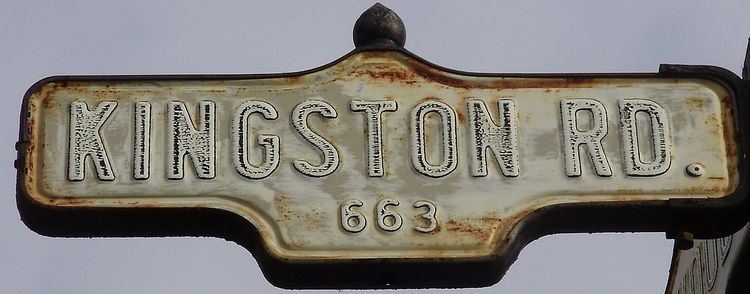Existed: 1817 – present Length 36.2 km | Towns: Ajax Constructed 1817 Town Ajax | |
 | ||
East end: Lake Ridge Road (Continues as Dundas Street into Whitby) | ||
Kingston Road is the southernmost major road along the eastern portion of Toronto, specifically in the district of Scarborough. Until 1998, it formed a significant portion of Highway 2. The name of the street is derived from Kingston, Ontario as the road was the primary route used to travel from Toronto to the settlements east of it situated along the shores of Lake Ontario; in the west end of Kingston, this highway was referred to as the York Road (referring to Toronto) until at least 1908.
Contents
Map of Kingston Rd, Ontario, Canada
Most major north-south roads in Scarborough end at this road, or sometimes continue for a short distance after as a residential road.
History
American engineer Asa Danforth Jr. was contracted to build a road as a route to connect Toronto (then called York) with the mouth of the Trent River in 1799 at a cost of $90.00 per mile. The road was completed by December 18, 1800, but was poorly maintained thereafter. In 1815 the Kingston Road was surveyed and it followed the line, in many cases, of the former road laid out by Asa Danforth as far as the Trent River. Beyond that point, the two historic roads diverge. The Kingston Road was completed in 1817, serving as a post road for stagecoaches delivering mail on a rigid schedule.
Route description
The Toronto section runs from Queen Street East, joining with Eastern Avenue, just west of Woodbine Avenue (route to Lake Shore Boulevard) through Scarborough to Toronto's eastern city limits with Durham Region, where it continues into Pickering and Ajax (as Durham Regional Highway 2), and officially ends where its name changes to Dundas Street in Whitby .
A small portion of road parallel to Kingston Road is called Old Kingston Road running near the Highland Creek, east of Morningside Avenue. The road reverts to the original route at the junction with the former Highway 2A, (as well as Military Trail). Other old, parallel sections to Highway 2, also called Old Kingston Road, exist in Ajax and Courtice, Ontario, although Kingston Road proper does not reach Courtice today. There is also an old section of the old Danforth Road in Grafton, Ontario.
The southwestern-most section in the Beaches area take the form of a historic urban street with storefronts, high pedestrian traffic, and streetcars. The speed limit in that section is 50 km/h (31 mph).
Until Highway 401 was constructed, Kingston Road was the principal route from Toronto to points east. Accordingly, it became the site of numerous inns and motels, many of which still dot the road, particularly in Scarborough. Now some of these inns are being demolished to make way for townhouse developments. Kingston Road is a six-lane principal arterial road through most of Scarborough, narrowing to four lanes in Durham, with a 60 km/h (37 mph) speed limit for the most part.
Public Transit
In Toronto, the street is served by the Toronto Transit Commission (TTC), which operates two streetcar (with one running only during peak periods) lines (with the 502 route streetcars being replaced by buses during evenings, weekends and holidays) west of Victoria Park Avenue and three bus routes further east in Scarborough. In Durham, Kingston Road is served by Durham Region Transit's (DRT) Pulse bus rapid transit and GO Transit, which both operate routes, originating in Toronto, with duplicate routing (although routing and termini are separate within Toronto) along it.
The regular routes (showing branches with maximum coverage) primarily serving the street are:
Toronto (TTC):
Durham Region (DRT) and GO Transit:
